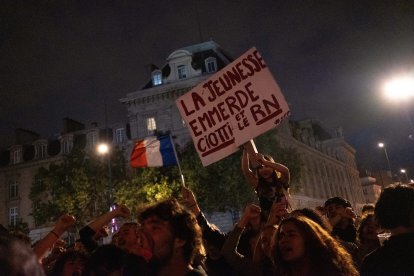France: Despite having the largest voter base, conservatives are disadvantaged by the constituency-based voting system
The RN party obtained the most votes in the second round of the French elections, surpassing the center and left coalitions, but this did not result into more seats for the right-wing party.

A boy holds a banner which says "La jeunesse emmerde Ciotti et le RN" (The youth are fed up with Ciotti and the RN).
The elections in France concluded this Sunday, leading to a situation of tension, confusion and possibly ungovernability among the main blocs and coalitions. While the National Rally (RN) and its allies fell short of their expectations, the New Popular Front (NFP) failed to secure a majority and the presidential center coalition Together (ENS) barely managed to hold its ground, contrary to predictions.
Despite this, the left in France interpreted the results as a victory. Both from the electorate and political formations, as well as much of the national and international press, shared this view. The NFP coalition, led by Mélenchon's La France Insoumise (LFI), immediately claimed that their party should lead the new French government. However, Melenchon's claimed victory and leadership role face significant rejection and the results cast doubt on these aspirations.

World
Elections in France: Macron gives victory to the radical left to stop the advance of conservatives
Emmanuel Alejandro Rondón
The left, without majority and volatile
Although the NFP coalition claims to be the parliamentary group with the most seats, the truth is that none of its constituent parties rank among the top two by seat count. This political alliance, united under the perceived "threat of the extreme right," previously split in when it was part of the NUPES (Nouvelles Union Populaire Écologique et Sociale). The NFP has increased its total seats from 142 to 182 seats. The significant winners within the coalition are the Socialists and the Greens, who have considerably expanded their numbers and thereby strenghtened their influence in the group.
The most radical political party within the coalition, and the one least willing to negotiate with the center, is LFI. It has not gained any seats, actually losing one and dropping from 75 to 74 representatives in the Assembly. In contrast, the Socialists increased their seats from 27 to 59 and the Ecologists from 16 to 28. Nevertheless, none of these parties individually reaches the seat count achieved by the RN.
Percentage ratio between votes and seats
In contrast, ENS has the most favorable ratio, with each percentaqge of votes translating into 1.08 seats in the Assembly. The NFP coalition had a ratio of 115% while the left and right minority groupings benefited the most, with rations of 136% and 125%, respectively.
RN, most voted political party
The left and the presidential center implemented a strategy in various constituencies to make a cordon sanitaire to the RN and its allies from Ciotti's Les Republicains (LR). They strategically withdrew candidates in certain areas to avoid splitting the vote, ensuring that a single candidate would always receive more votes than the RN.
However, despite this strategy, the RN emerged as the party with the most votes in these legislative elections. Running independently and not as part of a coalition, the RN secured 8.74 million votes, according to data of the French Ministry of the Interior. This puts more than one and a half million votes ahead of both the entire left-wing coalition NFP and the presidential coalition.
The constituency system punishes the RN
Despite obtaining more votes overall, this did not translate into more seats for Le Pen and Bardella's RN. The RN secured only 125 seats in the National Assembly, in addition to the 17 seats held by Ciotti's Les Republicains. In contrast, the Together (ENS) coalition obtained 168 seats across its constituent parties, thanks to 6.31 million voters.
Given the distinct constituency-based system for French elections, it is useful to recall the electoral landscape during the European elections. The National Front again achieved the highest vote share, with more over 32%. In that context, it became the leading political force, sending the most MEPs to the European Parliament. This is because, in the European Union elections, each country is treated as a single constituency, ensuring that all votes carry equal weight.
Governance in France
The fact that the RN has garnered more votes on its own than the center and right coalitions is significant in many respects. The disproportion does not imply that the French voting system is deficient or undemocratic, but it highlights the legitimacy of certain political messages and shows how the system allows for electoral engineering that may not align with the preferences of majorities. It also offers insight into the country's political and social climate and is an important factor to consider in the lead-up to the 2027 presidential elections.
RECOMMENDATION






















